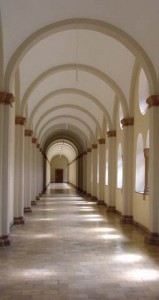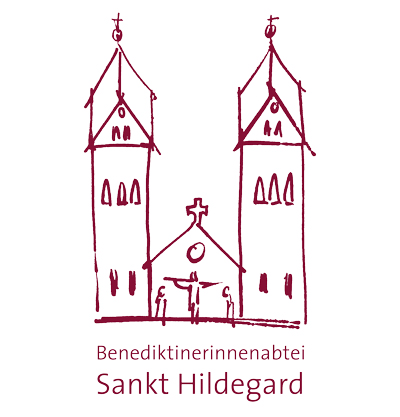The Development of the Abbey after 1945
 By July 2nd, 1945 – again the anniversary of the laying of the foundation stone – the Abbey buildings had been sufficiently repaired by the few sisters who had already returned and by many volunteers, so that the remainder of the expelled nuns could return home. On this day monastic life under the leadership of Abbess Regintrudis Sauter, now 80 years old, but still energetic, was taken up again. Many a young woman now asked for admission to the convent, so that with the steady increase in numbers the internal building-up of the community could also begin. In place of the bells, which had been confiscated during the war, four new bells were blessed by the Abbot of Maria Laach, Basilius Ebel, on July 1st, 1952.
By July 2nd, 1945 – again the anniversary of the laying of the foundation stone – the Abbey buildings had been sufficiently repaired by the few sisters who had already returned and by many volunteers, so that the remainder of the expelled nuns could return home. On this day monastic life under the leadership of Abbess Regintrudis Sauter, now 80 years old, but still energetic, was taken up again. Many a young woman now asked for admission to the convent, so that with the steady increase in numbers the internal building-up of the community could also begin. In place of the bells, which had been confiscated during the war, four new bells were blessed by the Abbot of Maria Laach, Basilius Ebel, on July 1st, 1952.
On August 4th, 1955 Abbess Regintrudis Sauter resigned at the age of 90 after 47 years in office. Her successor, Fortunata Fischer, was elected on August 8th. On September 17th, 1955 she received the blessing as Abbess by Walther Kampe, Suffragan Bishop of Limburg. Abbess Fortunata Fischer’s time in office was characterized by some significant innovations. In 1967 the two separate convents of choir nuns and lay sisters were brought together in one community. In accordance with the liturgical reforms of the Second Vatican Council the church’s sanctuary and nuns‘ choir were re-designed. The solemn consecration of the new altar on September 7th, 1967 marked the completion of both projects. In the following year a new organ could be installed. The wrought iron gates, which until then had marked the enclosure’s boundary between choir and church as well as in the visiting rooms, were taken down.
On August 8th, 1978 Abbess Fortunata Fischer resigned from office. Sr Edeltraud Forster, who was elected by the community on August 17th, 1978, succeeded her as third abbess of the new Abbey of St Hildegard, becoming the 38th successor to St Hildegard. Bishop Dr Wilhelm Kempf of Limburg blessed her as Abbess on September 15th, 1978. One of the most important dates of her time in office was May 5th, 1988. On this day ten sisters of the Eibingen convent resettled the former Cistercian Abbey Marienrode near Hildesheim and after a break of 180 years took up an old monastic tradition in Lower Saxony again. 84 years after the new foundation of the Abbey of St Hildegard, Benedictine life and the spiritual world and thought of St Hildegard bore fruit again in our time. Ten years later, on May 5th, 1998, the daughter house of Marienrode became an independent house, and Sr Maria-Elisabeth Bücker was appointed prioress-administrator for a four-year term by Abbess Edeltraud Forster. In the same year, after the conclusion of the great, eventful and blessed jubilee year celebrating the 900th birthday of St Hildegard, Abbess Edeltraud Forster resigned from office for reasons of age. On October 1st, Sr Gisela Happ was elected prioress-administrator.
On August 23rd, 2000, Sr Clementia Killewald was elected abbess and 39th successor of St Hildegard. On October 3rd, 2000 she was blessed as Abbess by Bishop Dr Franz Kamphaus of Limburg. Her motto is „Dominus ipse faciet“ (The Lord himself brings it to fruition). And finally, on May 28th, 2002, the convent at Marienrode elected Sr Maria-Elisabeth Bücker to be the convent’s prioress for 12 years. We trust that Abbess Clementia’s motto has to some extent already begun to be fulfilled in both of these houses in the tradition of St Hildegard.
